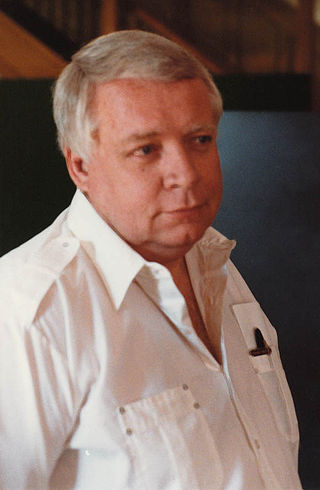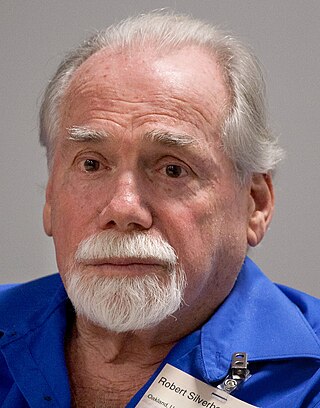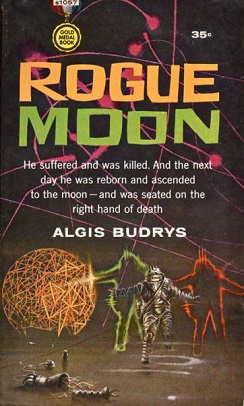
Horror is a genre of fiction that is intended to disturb, frighten or scare. Horror is often divided into the sub-genres of psychological horror and supernatural horror, which are in the realm of speculative fiction. Literary historian J. A. Cuddon, in 1984, defined the horror story as "a piece of fiction in prose of variable length... which shocks, or even frightens the reader, or perhaps induces a feeling of repulsion or loathing". Horror intends to create an eerie and frightening atmosphere for the reader. Often the central menace of a work of horror fiction can be interpreted as a metaphor for larger fears of a society.

Algirdas Jonas "Algis" Budrys was a Lithuanian-American science fiction author, editor, and critic. He was also known under the pen names Frank Mason, Alger Rome in collaboration with Jerome Bixby, John A. Sentry, William Scarff, and Paul Janvier. In 1960, he authored Rogue Moon, a novel.

Robert Silverberg is an American author and editor, best known for writing science fiction. He is a multiple winner of both Hugo and Nebula Awards, a member of the Science Fiction and Fantasy Hall of Fame, and a Grand Master of SF. He has attended every Hugo Award ceremony since the inaugural event in 1953.

Michael Shea was an American fantasy, horror, and science fiction author. His novel Nifft the Lean won the World Fantasy Award, as did his novella Growlimb.

George Oliver Onions, who published under the name Oliver Onions, was an English writer of short stories and novels. He wrote in various genres, but is perhaps best remembered for his ghost stories, notably the collection Widdershins and the widely anthologized novella "The Beckoning Fair One". He was married to the novelist Berta Ruck.
Supernatural fiction or supernaturalist fiction is a genre of speculative fiction that exploits or is centered on supernatural themes, often contradicting naturalist assumptions of the real world.
Thomas L. Sherred was an American science fiction writer.
Ray Russell was an American editor and writer of short stories, novels, and screenplays. Russell is best known for his horror fiction, although he also wrote mystery and science fiction stories.

Rogue Moon is a short science fiction novel by Lithuanian-American writer Algis Budrys, published in 1960. It was a 1961 Hugo Award nominee. A substantially shortened version of the novel was originally published in F&SF; this novella-length story was included in The Science Fiction Hall of Fame, Volume Two, edited by Ben Bova. It was adapted into a radio drama by Yuri Rasovsky in 1979.
"If All Men Were Brothers, Would You Let One Marry Your Sister?" is a science fiction short story by American writer Theodore Sturgeon. It first appeared in Harlan Ellison's anthology Dangerous Visions in 1967.
"Twilight" is a post-apocalyptic science fiction short story by American author John W. Campbell. It was originally published in 1934 in Astounding Stories and apparently inspired by H. G. Wells' article The Man of the Year Million. In 1970, it was selected as one of the best science fiction short stories published before the creation of the Nebula Awards by the Science Fiction Writers of America. As such, it was published in The Science Fiction Hall of Fame Volume One, 1929-1964.
Lafayette Ronald Hubbard, better known as L. Ron Hubbard, was an American pulp fiction author. He wrote in a wide variety of genres, including science fiction, fantasy, adventure fiction, aviation, travel, mystery, western, and romance. His United States publisher and distributor is Galaxy Press. He is perhaps best known for his self-help book, the #1 New York Times bestseller Dianetics: The Modern Science of Mental Health, and as the founder of the Church of Scientology.
Simon McCaffery is an American author of speculative fiction. Trained as a journalist and magazine editor, he was an Honorable Mention recipient in the L. Ron Hubbard Writers of the Future contest twice before he began publishing short fiction in a variety of professional science fiction, horror and mystery publications in the 1990s, including Alfred Hitchcock's Mystery Magazine, Tomorrow SF, and Space and Time. He was a contributor in the anthology, Other Worlds Than These, edited by John Joseph Adams, alongside authors Stephen King and Ian McDonald. His fiction has also been collected in anthologies including the "Book of the Dead" series edited by Splatterpunk authors John Mason Skipp and Craig Spector, 100 Wicked Little Witch Stories, ''Mondo Zombie", and The Haunted Hour.

Typewriter in the Sky is a science fantasy novel by American writer L. Ron Hubbard. The protagonist Mike de Wolf finds himself inside the story of his friend Horace Hackett's book. He must survive conflict on the high seas in the Caribbean during the 17th century, before eventually returning to his native New York City. Each time a significant event occurs to the protagonist in the story he hears the sounds of a typewriter in the sky. At the story's conclusion, de Wolf wonders if he is still a character in someone else's story. The work was first published in a two-part serial format in 1940 in Unknown Fantasy Fiction. It was twice published as a combined book with Hubbard's work Fear. In 1995 Bridge Publications re-released the work along with an audio edition.

Seekers of Tomorrow: Masters of Modern Science Fiction is a work of collective biography on the formative authors of the science fiction genre by Sam Moskowitz, first published in hardcover by the World Publishing Company in 1965. The first paperback edition was issued by Ballantine Books in October, 1967. A photographic reprint of the original edition was issued in both hardcover and trade paperback by Hyperion Press in 1974. Most of its chapters are revised versions of articles that initially appeared in the magazine Amazing Stories from 1961 to 1964.

Nebula Awards 21 is an anthology of award-winning science fiction short works edited by George Zebrowski, the second of three successive volumes under his editorship. It was first published in trade paperback by Harcourt Brace Jovanovich in December 1986, with a hardcover edition following from the same publisher in January 1987.

Nebula Awards 20 is an anthology of award winning science fiction short works edited by George Zebrowski. It was first published in hardcover and trade paperback by Harcourt Brace Jovanovich in November 1985.

Nebula Award Stories Seventeen is an anthology of award winning science fiction short works edited by Joe Haldeman. It was first published in hardcover by Holt, Rinehart and Winston in August 1983; a paperback edition was issued by Ace Books in June 1985 under the variant title Nebula Award Stories 17.

Brian Lee Durfee is an American wildlife, landscape, and fantasy painter, and a fantasy and horror writer. His paintings have appeared in various genre and other magazines, games, and books. One of his wildlife paintings is in the permanent collection at the Grand Canyon National Park visitors center.

The Best of Edmond Hamilton is a collection of science fiction short stories by American author Edmond Hamilton, edited by his wife and fellow science fiction writer Leigh Brackett. It was first published in hardback by Nelson Doubleday in April 1977 and in paperback by Ballantine Books in August of the same year as a volume in its Classic Library of Science Fiction. The book was reissued in trade paperback and ebook editions by Phoenix Pick in November 2010. It has also been translated into German.













